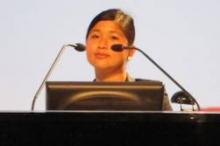MILAN – A new chemotherapy regimen of prednisone, vinblastine, doxorubicin, and gemcitabine provides tumor control with far less toxicity than standard therapy for early, unfavorable Hodgkin’s lymphoma, according to a phase II study.
After a median follow-up of 27 months, 95%, or all but 1 of the 41 patients, achieved complete remission (CR or CR unconfirmed) with PVAG-14 chemotherapy. The study had aimed for a CR rate of 50% or more. Grade 3/4 hematologic toxicity occurred in 9.8% of patients, markedly lower than the study’s target of 50% or less.
Any grade 3/4 toxicity was reported in 36.6% of patients. This also betters the 51% grade 3/4 toxicity rate reported with four cycles of standard ABVD (Adriamycin [doxorubicin], bleomycin, vinblastine, and dacarbazine) chemotherapy in the German Hodgkin Study Group’s HD14 trial, Dr. Diana Wongso reported at the annual congress of the European Hematology Association.
"PVAG-14 might be an effective and less toxic alternative to 2+2 [chemotherapy] and should be tested in a phase III trial," she said.
The German Hodgkin Study Group designed the PVAG-14 regimen because treatment for early, unfavorable disease with two cycles each of ABVD and BEACOPP (bleomycin, etoposide, doxorubicin, cyclophosphamide, vincristine, procarbazine, and prednisone) chemotherapy (2+2) is toxic, more cycles do not improve outcome, and gemcitabine (Gemzar) has shown promising activity in relapsed Hodgkin’s lymphoma, explained Dr. Wongso of the University Hospital of Cologne (Germany).
The phase II study randomized patients with stage I/II newly diagnosed Hodgkin’s lymphoma to receive eight cycles of prednisone 50 mg on days 1-3, vinblastine 6 mg/m2 on day 1, and gemcitabine 1,000 mg/m2 on day 1 with two different doses of doxorubicin (25 or 35 mg/m2 on day 1) followed by 30 Gy of involved-field radiotherapy. Pegfilgrastim (Neulasta) 6 mg was given on day 2 of each cycle.
The trial was designed to enroll 50 patients per arm, but recruitment was stopped because of poor accrual after 41 patients, she said.
Most patients (76%) had stage IIA disease and a WHO Activity Index of 0. A large mediastinal mass was present in 20% of patients, 61% had at least three nodal areas involved, and 51% had a high erythrocyte sedimentation rate. Patients’ median age was 38 years.
All but one patient received eight cycles of PVAG-14 with a median dose intensity of 97.6%, and 27 patients received pegfilgrastim in each cycle.
Grade 3/4 hematologic toxicity was 9.8% overall, 4.8% in patients receiving doxorubicin at the 25-mg dose, and 15% in those given the doxorubicin 35-mg dose, Dr. Wongso said.
The most common grade 3/4 toxicities were leucopenia in 9.8%, infection in 7.3%, nausea/vomiting in 7.3%, and skin toxicity in 7.3%. There was no treatment-associated anemia or thrombocytopenia.
Overall survival was 94.4% at 30 months, and 2-year progression-free survival was 94.2%. This is comparable with a progression-free survival rate of 93% in the HD14 trial and a rate of 97% reported with 2+2 chemotherapy, she said. Comparison with the different doxorubicin doses was not possible because of the low number of patients.
One patient progressed 5 months after the end of therapy, and one relapsed 15 months after completing therapy. One Hodgkin’s-related death occurred on study, 27 months after first diagnosis and 1 month after the diagnosis of a second relapse, Dr. Wongso reported on behalf of lead author and colleague Dr. Michael Fuchs.
Dr. Wongso disclosed that participation in the EHA Congress was financed by Takeda Pharmaceuticals. Dr. Fuchs reported no conflicting interests.


